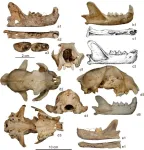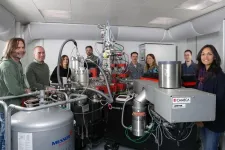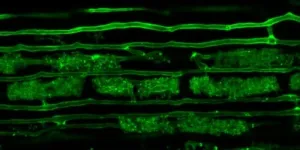(Press-News.org) A small helper for big tasks: an oxygen sensor protein protects the enzymatic machinery of biological nitrogen fixation from serious damage. Its use in biotechnology could help to reduce the use of synthetic fertiliser in agriculture in the future. A research team led by biochemist Prof. Dr Oliver Einsle from the Faculty of Chemistry and Pharmacy and the Centre for Biological Signalling Studies (BIOSS) at the University of Freiburg has discovered exactly how the so-called Shethna protein II works. The scientists used the newly established cryo-electron microscopy in Freiburg. Their results have been published in the journal Nature.
Nitrogen fertiliser is ecologically problematic
The element nitrogen is an essential component of all living organisms; in agriculture, it is often added as fertiliser to enable high yields over the long term. However, the production and application of these fertilisers is problematic in terms of energy and the environment. For years, attempts have therefore been made to transfer the natural nitrogen fixation in bacteria and archaea to crops. The enzyme nitrogenase is responsible for the binding of nitrogen. One of the most serious problems with the transfer to plants is that nitrogenase is extremely sensitive to atmospheric oxygen, which is produced by plants themselves during the process of photosynthesis.
Shethna protein II forms a complex with the enzyme nitrogenase.
Philipp Franke, Simon Freiberger and Dr. Lin Zhang from the team led by Prof. Oliver Einsle has now been able to show how a small factor, the Shethna protein II, registers an increase in oxygen concentration. It then very quickly forms a complex with the two components of the enzyme nitrogenase, which protects them from oxidative damage. In this process, the activated Shethna protein II binds the much larger nitrogenase and its associated reductase, forming long filaments with both proteins in which oxygen cannot reach the active centres of the nitrogenase. As soon as the cells overcome this oxidative stress, the complex dissolves and the enzyme can resume its work.
Use in plant cells is conceivable
Even if nitrogenase is produced directly in plant cells, it is likely that such short stress phases with increased oxygen concentrations will occur again and again. In the case of biotechnological use, the co-production of the small Shethna protein II could then help to protect the elaborately synthesised enzymes in their new environment and maintain their function in the plant cell. “The production of functioning nitrogenase in plants would initiate a paradigm shift in green biotechnology, and this small protein can make a decisive contribution to making this possible,” says Einsle.
Original publication: Franke, P., Freiberger, S., Zhang, L., Einsle, O.: Conformational protection of molybdenum nitrogenase by Shethna protein II. In: Nature (2025).
DOI: https://doi.org/10.1038/s41586-024-08355-3
Prof. Dr Oliver Einsle is a professor of biochemistry at the Faculty of Chemistry and Pharmacy and a member of the Centre for Biological Signalling Studies (BIOSS) at the University of Freiburg. His research focuses on the structure, function and biogenesis of complex enzyme systems. Philipp Franke, Simon Freiberger and Dr. Lin Zhang are members of Oliver Einsle's research group.
The project was funded by the European Union with an ERC Advanced Grant for Prof. Dr. Oliver Einsle and by the German Research Foundation (DFG) as part of the Collaborative Research Centre ‘Dynamic Organization of Cellular Protein Machineries’.
Contact
Office of University and Science Communications
University of Freiburg
Tel.: 0761/203-4302
e-mail: kommunikation@zv.uni-freiburg.de
END
Protein protects biological nitrogen fixation from oxidative stress
2025-01-15
ELSE PRESS RELEASES FROM THIS DATE:
Three-quarters of medical facilities in Mariupol sustained damage during Russia’s siege of 2022
2025-01-15
Three-quarters of medical facilities in Mariupol sustained damage during Russia’s siege of 2022, with some evidence that the attacks may have been intentionally targeted, per study using satellite imagery.
####
Article URL: https://journals.plos.org/globalpublichealth/article?id=10.1371/journal.pgph.0003950
Article Title: The effect of conflict on damage to medical facilities in Mariupol, Ukraine: a quasi-experimental study
Author Countries: Germany, United States
Funding: This work was supported ...
Snow leopard fossils clarify evolutionary history of species
2025-01-15
The snow leopard (Panthera uncia) is a large feline unique to the Qinghai-Tibet Plateau and its surrounding areas. As the apex predator in the region, the snow leopard plays a crucial role in maintaining ecological stability. Its unique characteristics, coupled with its striking appearance, have made it a flagship species for conservation efforts aimed at protecting the ecosystem of the Qinghai-Tibet Plateau.
Unfortunately, few snow leopard fossils have been found in the Qinghai-Tibet Plateau region, particularly fossils from the Quaternary period. As a result, it’s unclear how snow leopards evolved their specialized adaptations to this environment.
On the one hand, molecular ...
Machine learning outperforms traditional statistical methods in addressing missing data in electronic health records
2025-01-15
Researchers from the National Institute of Health Data Science at Peking University and the Department of Clinical Epidemiology and Biostatistics at Peking University People's Hospital have conducted a comprehensive systematic review evaluating strategies for addressing missing data in electronic health records (EHRs). Published in Health Data Science, the study highlights the growing importance of machine learning methods over traditional statistical approaches in managing missing data scenarios effectively.
Electronic health records have become a cornerstone in modern healthcare research, enabling analysis across clinical trials, treatment effectiveness studies, and ...
AI–guided lung ultrasound by nonexperts
2025-01-15
About The Study: In this multicenter validation study, trained health care professionals with artificial intelligence (AI) assistance achieved lung ultrasound images meeting diagnostic standards compared with lung ultrasound experts without AI. This technology could extend access to lung ultrasound to underserved areas lacking expert personnel.
Corresponding Author: To contact the corresponding author, Cristiana Baloescu, MD, MPH, email cristiana.baloescu@yale.edu.
To access the embargoed ...
Prevalence of and inequities in poor mental health across 3 US surveys
2025-01-15
About The Study: This survey study documents increasingly prevalent poor mental health from 2011 to 2022 across multiple U.S. health surveys, with notable prevalence differences in Behavioral Risk Factor Surveillance System and National Survey on Drug Use and Health vs National Health Interview Survey. Inequities in these outcomes by age, sex, and racial and ethnic group were often sizeable and changed over time in distinct ways, consistent with findings in prior literature.
Corresponding Author: To contact the corresponding ...
Association between surgeon stress and major surgical complications
2025-01-15
About The Study: In this cohort study including 38 attending surgeons and 793 patients, increased surgeon stress at the beginning of a procedure was associated with improved clinical patient outcomes. The results are illustrative of the complex relationship between physiological stress and performance, identify a novel association between measurable surgeon human factors and patient outcomes, and may highlight opportunities to improve patient care.
Corresponding Author: To contact the corresponding author, Jake Awtry, MD, email jawtry@bwh.harvard.edu.
To access the embargoed study: Visit our For The Media ...
How cryogenic microscopy could help strengthen food security
2025-01-15
According to the United Nations, soil salinization affects between 20% and 40% of arable land globally, with human activity and climate change – especially rising sea levels – largely responsible for this process. While the human body needs sodium to function, this is not the case for most plants. In fact, excess salt around plants’ roots gradually blocks their access to water, stunting their growth, poisoning them and hastening their death. Ten million hectares of farmland are destroyed by soil salinization every year, posing a threat to global food security.
Scientists at EPFL, ...
DNA damage can last unrepaired for years, changing our view of mutations
2025-01-15
While most known types of DNA damage are fixed by our cells’ in-house DNA repair mechanisms, some forms of DNA damage evade repair and can persist for many years, new research shows. This means that the damage has multiple chances to generate harmful mutations, which can lead to cancer.
Scientists from the Wellcome Sanger Institute and their collaborators analysed family trees of hundreds of single cells from several individuals. The team pieced together these family trees from patterns of shared mutations between the cells, indicating common ancestors.
Researchers uncovered unexpected ...
Could this fundamental discovery revolutionise fertiliser use in farming?
2025-01-15
Researchers have discovered a biological mechanism that makes plant roots more welcoming to beneficial soil microbes.
This discovery by John Innes Centre researchers paves the way for more environmentally friendly farming practices, potentially allowing farmers to use less fertiliser.
Production of most major crops relies on nitrate and phosphate fertilisers, but excessive fertiliser use harms the environment.
If we could use mutually beneficial relationships between plant roots and soil microbes to enhance nutrient uptake, ...
How one brain circuit encodes memories of both places and events
2025-01-15
CAMBRIDGE, MA -- Nearly 50 years ago, neuroscientists discovered cells within the brain’s hippocampus that store memories of specific locations. These cells also play an important role in storing memories of events, known as episodic memories. While the mechanism of how place cells encode spatial memory has been well-characterized, it has remained a puzzle how they encode episodic memories.
A new model developed by MIT researchers explains how those place cells can be recruited to form episodic memories, even when there’s no spatial component. According to this model, place cells, along with grid cells found in the entorhinal cortex, act as a scaffold ...



